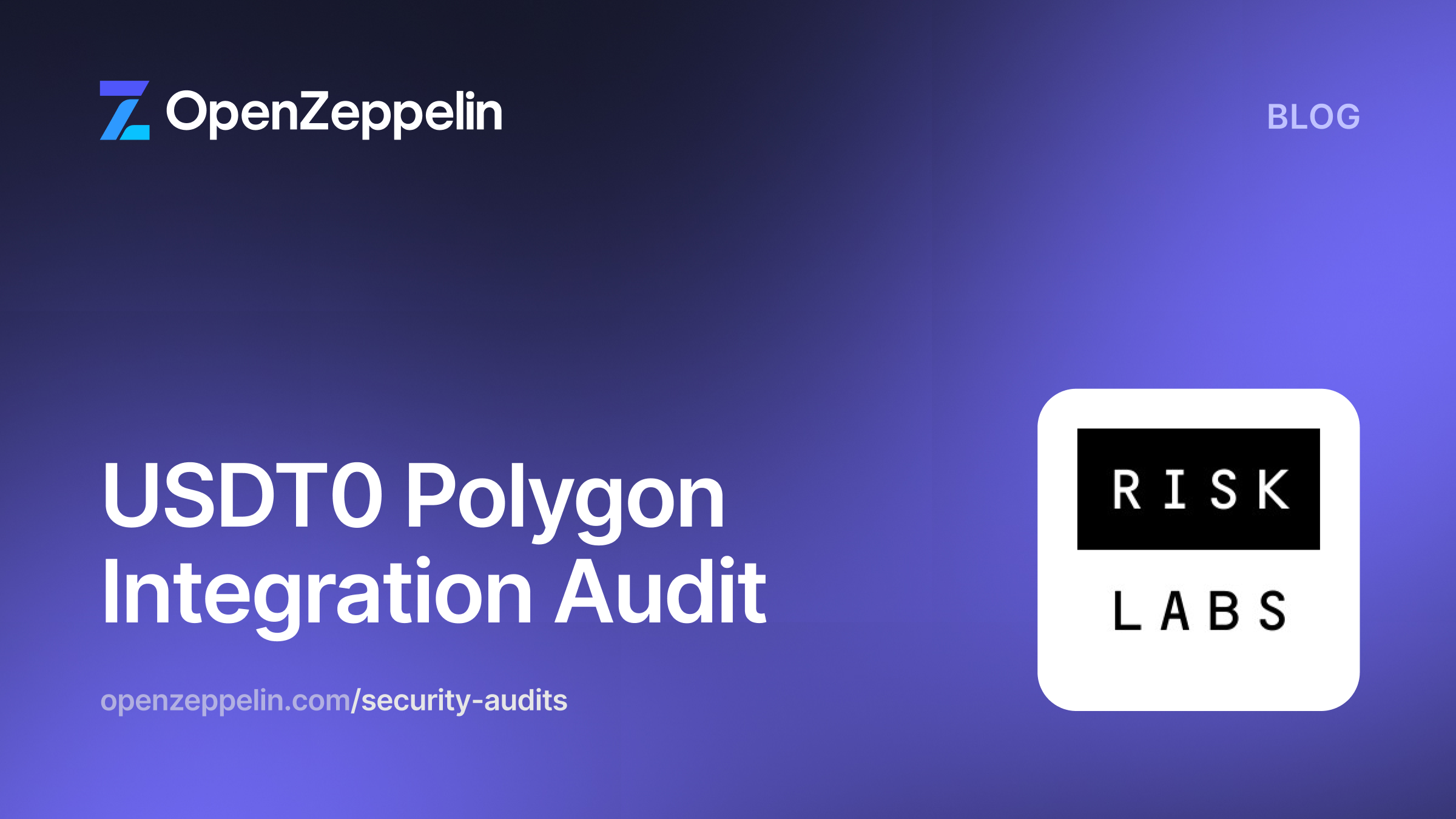May 10th, 2022
This security assessment was prepared by OpenZeppelin, protecting the open economy.
Table of Contents
Summary
- Type
- DeFi
- Timeline
- From 2022-04-25
- To 2022-05-10
- Languages
- Solidity
- Total Issues
- 13 (13 resolved)
- Critical Severity Issues
- 0 (0 resolved)
- High Severity Issues
- 1 (1 resolved)
- Medium Severity Issues
- 1 (1 resolved)
- Low Severity Issues
- 4 (4 resolved)
- Notes & Additional Information
- 7 (7 resolved)
Scope
We audited the across-protocol/across-token repository at commit 42130387f81debf2a20d2f7b40d9f0ccc1dcd06a.
In scope were the following contracts:
- AcceleratingDistributor.sol
- AcrossToken.sol
System Overview
The system is composed of the Across token (ACX) and the Across token distributor. Together, these are meant to facilitate a liquidity mining program that will accompany the launch of the most recent version of the Across protocol.
The Across token is an ERC20 compliant token.
The Across token distributor allows users to stake whitelisted ERC20 tokens (LP tokens) to earn ACX rewards. At deposit time depositors earn a fixed base emission rate. The longer depositors keep their tokens staked, the higher the reward rate they earn. The reward rate is capped at a value set by the owner of the distributor. Sequential deposits result in an average deposit time as a weighted average of previous deposits. If at any point the depositor claims their rewards or unstakes all LP tokens, then their rewards emission rate is reset to the base rate. The contract is designed to hold multiple LP tokens, each with independent parameterization for liquidity mining.
Privileged Roles
Each contract has only one privileged role, which is the contract’s respective owner.
The Across token’s owner can mint and burn the token. The owner can also renounce and transfer ownership.
The Across token distributor’s owner can also transfer and renounce ownership. In addition, the owner is the only account which receives tokens recovered from the contract, which are comprised of tokens which were mistakenly sent to and are retrievable from the contract. Finally, the owner can enable and disable tokens for staking and change parameters of enabled LP tokens. These parameters are set per-token and include the base ACX emission rate, an emission rate cap, and time needed to reach the emission rate cap.
Findings
Here we present our findings.
High Severity
Anyone can prevent stakers from getting their rewards
The recoverErc20 function is meant to facilitate the recovery of any ERC20 tokens that may be mistakenly sent to the AcceleratingDistributor contract. As this is a public function with no modifiers, anyone can call this function to transfer an ERC20 token from the AcceleratingDistributor contract to the owner of AcceleratingDistributor. The only ERC20 tokens that are explicitly disallowed from being recovered are stakedTokens that have already been initialized in the system.
However, it is currently possible to recover the ERC20 rewardToken using the recoverErc20 function. Doing so would transfer some specified amount of rewardToken from the AcceleratingDistributor contract to the contract’s owner. This would, subsequently, prevent stakers from being able to access their rewards because AcceleratingDistributor could be left with an insufficient balance of rewardTokens.
Even if the owner were to send rewardTokens back to the AcceleratingDistributor contract, a malicious actor could immediately transfer all of the rewardTokens back to the owner. Redeployment would be necessary to fix the issue.
Consider disallowing recovery of the rewardToken within the recoverErc20 function.
Update: Fixed as of commit bcdabc06ca6d789b95c5b26d23f48dab8bfad277 in pull request #5.
Medium Severity
Lack of input validation
The codebase generally lacks sufficient input validation.
In the AcceleratingDistributor contract, the enableStaking function allows the contract owner to configure several parameters associated with a stakedToken. Several of these parameters have no input checking. Specifically:
- The
maxMultiplierparameter has no upper or lower bound. - It should be restricted to being larger than the “base multiplier” of
1e18, or else it can lead to users’ staking rewards decreasing over time rather than increasing. - It should also have an upper bound, because if it were to be set to some very large value it could cause the
getUserRewardMultiplierfunction to revert on overflow. This could, in turn, cause calls to thegetOutstandingRewardsand_updateRewardfunctions to revert. This would interfere with the normal operation of the system. However, it could be fixed by the contract owner using theenableStakingfunction to update to a more reasonablemaxMultiplier. - Similarly, the
secondsToMaxMultiplierparameter has no lower bound. If allowed to be zero thengetUserRewardMultipliercould revert due to division by zero. This could cause thegetOutstandingRewardsand_updateRewardfunctions to revert as outlined above. The contract owner could put the system back into a stable state by makingsecondsToMaxMultipliernon-zero. - The
baseEmissionRateparameter has no upper bound. If set too high then, as soon asstakingToken.cumulativeStakedwere some non-zero value, thebaseRewardPerTokenfunction would always revert due to an overflow. Importantly, this value could be set to a system destabilizing value even whenstakingToken.cumulativeStakedwas already non-zero. This would cause_updateRewardto revert even in the case that the provided account was the zero address. This detail would prevent the contract owner from fixing the situation without a complete redeployment of the system if anystakedTokenat all were actively being staked. AnystakedTokenalready in the contract would be locked.
To avoid errors and unexpected system behavior, consider implementing require statements to validate all user-controlled input.
Update: Fixed as of commit 9652a990a14d00e4d47f9e4f3df2c422a6881d4a in pull request #6 and commit 3a4a6382b88f40fa9d816e5e5b1d3a31a7b24f27 in pull request #20.
Low Severity
Incomplete and unindexed events
Throughout the codebase, events are used to signify when changes are made to the state of the system. However, all of the existing events lack indexed parameters. Some events are missing parameters necessary to fully indicate how the state was modified during a call.
Events lacking indexed parameters include:
- The
TokenEnabledForStaking,RecoverErc20,Stake,Unstake,GetReward, andExitevents in theAcceleratingDistributorcontract.
Event emissions which do not fully track state changes include:
- The
RecoverErc20event does not emit the caller, which may be of interest to those interested in calls to therecoverErc20function where the event is emitted. - The
Stake,Unstake, andExitevents are emitted when a user calls thestake,unstake, orexitfunctions, respectively. These functions update thestakedToken‘scumulativeStakedvalue, but this is not emitted in the events. Similarly, these functions – as well as thegetRewardfunction – update astakedToken‘slastUpdateTimeandrewardPerTokenStoredas well as auserDeposit‘srewardsOutstandingandrewardsPaidPerTokenvalues, but these state changes are not captured by any associated event emissions.
Consider completely indexing existing events, adding new indexed parameters where they are lacking, and/or adding new events to facilitate off-chain services searching and filtering for events. Consider emitting all events in such a complete manner that they could be used to rebuild the state of the contract.
Update: Fixed as of commit 71178ca0ce24633eb4644f64094f455862edf5e9 in pull request #7 and commit 3a4a6382b88f40fa9d816e5e5b1d3a31a7b24f27 in pull request #20.
Recovery function is not robust
Within the AcceleratingDistributor contract, the recoverErc20 function is intended to facilitate the recovery of tokens which may have been sent to the contract in error. Without such a function, tokens sent to the contract in error would generally become completely inaccessible.
However, the current implementation of the recovery function is less robust than may be desirable.
For instance, all recovered tokens are hard-coded to be sent to the contract’s owner. But the contract also has the ability to relinquish ownership, whereby the owner is set to the zero address. After ownership is relinquished then, the recovery function can no longer perform its intended purpose.
Additionally, any tokens that have ever been enabled for staking are not recoverable. Unfortunately, it is precisely tokens that are or were eligible to be staked that are most likely to be sent to the contract in error, especially by users trying to stake with the protocol in an incorrect manner.
To better separate concerns, consider having tokens recovered to a recovery address that is independent of the owner. Alternatively, consider explicitly documenting the fact that token recoverability is dependent on an owner address that can be controlled. Also, since the cumulativeStaked amount for every staking token is already accounted for, consider using it to allow for the recovery of staking tokens which were sent in error and are, as a result, unaccounted for.
Update: Fixed as of commit 0cc740ecc30694077d44674d80b48c4e6d75ce31 in pull request #8.
Unhandled failures in token interactions
There are ERC20 transfer operations, executed over potentially untrusted ERC20 tokens, which are not correctly wrapped to ensure that they are always safe and behave as expected.
Specifically, for the transfer on line 177 of the AcceleratingDistributor contract, the current implementation does not handle a case where the call to transfer fails by returning a false boolean value (rather than reverting the transaction).
For more predictable and consistent behavior, consider using the OpenZeppelin SafeERC20 library which is used for other transfers throughout the codebase, as it implements wrappers around ERC20 operations that return false on failure.
Update: Fixed as of commit 3722baff5cf0ee936b43ecf07ae47b44b3f5688d in pull request #9.
Unused inherited contracts
The AcceleratingDistributor contract imports and inherits from the Pausable contract but does not use any of the inherited functionality.
Consider either using the inherited Pausable functionality or else not inheriting from the Pausable contract.
Update: Fixed as of commit b511e0d96a18d1087da60e2e02ee18120eb0a291 in pull request #10.
Notes & Additional Information
Visibility unnecessarily permissive
The mint and burn functions of the AcrossToken contract and enableStaking, stake, getCumulativeStaked, and getUserStake of the AcceleratingDistributor contract are marked as public, while they could be marked as external.
Update: Fixed as of commit 0f027e6cb8ae146a755de3041172efc76bb87d5f in pull request #11 and commit 3a4a6382b88f40fa9d816e5e5b1d3a31a7b24f27 in pull request #20.
System is incompatible with non-standard ERC20 tokens
Currently, the system is incompatible with non-standard ERC20 tokens and enabling such tokens for staking could lead to loss of funds in the following ways:
- The system’s internal accounting mechanism does not currently support tokens that can charge fees on transfers, such as Tether (USDT) (the most widely known asset with this feature). This means that such tokens’
transferandtransferFromfunctions could potentially fail to increase the recipient’s balance by the amount that is actually transferred.IfAcceleratingDistributorallows staking of tokens charging such transfer fees, then stakers would receive more rewards than intended. - The
recoverErc20function is currently callable by any address. This could be problematic if the system were to allow staking of non-standard ERC20 tokens, particularly if those tokens were to have a double entry point. In such a case the current restrictions may not be sufficient to restrict such tokens’ recovery via therecoverErc20function (e.g. Compound-TUSD Integration Issue Retrospective).
If the protocol is expected to be compatible with these types of non-standard ERC20 tokens, then consider modifying the internal accounting mechanisms so that they properly track the actual amount of assets deposited. Additionally, consider limiting the recoverErc20 function so that is can only be called from trusted accounts.
Alternatively, consider documenting that the system is incompatible with non-standard ERC20 tokens and ensuring the contract owner thoroughly vets any ERC20 tokens that are enabled for staking. If the recoverErc20 function is left unrestricted, then consider moving it out of the ADMIN section of the codebase.
Update: Fixed as of commit 5ea4099a44e5edfa5e84cc65e744cf546d7f5957 in pull request #12 and commit 3a4a6382b88f40fa9d816e5e5b1d3a31a7b24f27 in pull request #20.
Misleading function names
In the AcceleratingDistributor contract there are multiple functions, storage variables, and events that have misleading names. These could potentially confuse users and lead to unintentional or unexpected consequences when interacting with the contract. For instance:
- The function name
enableStakingimplies that it can only be used to enable a staking token. However, the function can be used to enable or disable a staking token, and/or modify the propertiesbaseEmissionRate,maxMultiplierorsecondsToMaxMultiplier. Consider renaming the function toconfigureStakingToken. - The
enableStakingfunction emits the eventTokenEnabledForStaking. Consider renaming the event to better reflect the actual use case of the emitting function as outlined in the above bullet point. - The function prefix
gettypically indicates a view function, however the functiongetRewardtransfers outstanding rewards to the caller. Consider renaming it towithdrawReward. - The function name
getTimeFromLastDepositimplies that a difference between the current time and the last time of deposit is returned. However, the difference is calculated using the weighted average deposit time. Consider renaming it togetTimeSinceAverageDeposit. - The variable name
rewardsPaidPerTokenappears to imply that the rewards contained can be distributed or have already been distributed to the individual user. However, this variable is used as a helper variable to allow accurate bookkeeping of therewardsOustandingvariable, which contains the funds that are actually withdrawable to the individual user. Consider renamingrewardsPaidPerTokentorewardsAccumulatedPerToken.
Update: Fixed as of commit 5db3215559fad05ebf98ac9f2bd91187a1e442d7 in pull request #13.
Missing documentation details
In the AcceleratingDistributor contract several parts of the documentation contain missing or misleading details. For instance:
- The functions
getUserRewardMultiplierandbaseRewardPerTokenreturn ratios or multipliers represented by auint256value with a fixed precision of 18 decimals. However, the decimal precision used is not documented. - The contract-level documentation refers to a
maxEmissionRate. However, the implementation uses amaxMultiplierwhich is multiplied with abaseEmissionRateinstead.
To increase the overall readability of the codebase and reduce potential confusion, consider clarifying the documentation and adding missing details where appropriate.
Update: Fixed as of commit e3e7cf1c46304accc73f25a70f14036841e81239 in pull request #14.
Not using immutable
In the AcceleratingDistributor contract the rewardToken variable could be marked immutable given that is only ever set in the constructor.
If rewardToken is never meant to be modifiable, then consider marking it immutable to better signal intent and reduce gas consumption.
Update: Fixed as of commit 973e002a92e646f5e3af74d235a1e77d03bd69a0 in pull request #15.
Test code in production could have security implications
As we have raised in prior audits (issue L12) test code in production code is less than ideal. We will not simply rehash our previously raised concerns and suggestions, but we do feel it prudent to expound on some of the potential security implications of having test code in production in this particular case:
The AcceleratingDistributor contract inherits from the Testable contract. This facilitates modification of the getCurrentTime function’s behavior during testing. This inheritance is meant to be kept in production. This is considered safe because passing the zero address for the parameter _timer during deployment will disable the testing module and return block.timestamp instead.
The contract logic ensures that all staked tokens can be unstaked by their respective owners and that all rewards can be collected even if further staking is disabled by the contract owner. Calls to unstake and getReward are guarded by a modifier which ensures only that a token had been enabled for staking at some time – not that it is currently enabled for staking. It does this by verifying the token’s lastUpdateTime is greater than zero. The contract owner is not meant to be able to set lastUpdateTime in production and it is guaranteed to be greater than zero for each token that has previously been enabled for staking.
However, a malicious operator could deploy the code with the address _timer pointing to a smart contract that allows the attacker to arbitrarily change time. They could at first report accurate block times and then wait until a significant portion of staked TVL is accumulated. Later, they could change the reported time to zero. As a consequence, users would be unable to unstake or obtain rewards. What’s worse, the malicious operator could then steal all staked TVL via recoverERC20 (which would no longer recognize the staked token as such when their lastUpdateTime was equal to zero).
A potential risk here is that a third party could uses this exact code, misusing the Testable functionality to be genuinely malicious. Since ecosystem tools such as Etherscan can do exact matching on bytecode, the malicious deployment could end up being directly linked to the Across protocol, which could lead to some loss of reputation.
As this is a fairly general-purpose, user-facing system, with an open source license, we can certainly imagine it being reused. The subtleties of the deployment can have drastic implications for the security model of the deployed system. Normalizing such designs can have unintended consequences for users, but also for projects that may inadvertently suffer from mere association with some malicious deployment.
Consider better isolating test and production code where possible. When this is not possible, consider bolstering the warnings in the code so that even casual users could better understand the implications if system variables are are not set as intended in production.
Update: Fixed as of commit 144293ec5b81c3367ad58738d7bca273b3e8a9e4 in pull request #16.
Typographical errors
The codebase contains the following typographical errors:
In AcceleratingDistributor.sol:
- On line 17 and line 89
pro-rateshould bepro-rata. - On line 126,
after the end of the staking program endsis ungrammatical. - On line 202,
existsshould beexits. - On line 203,
callersshould becaller's. - On line 228,
the all information associatedshould beall the information associated.
Consider correcting these typos to improve the overall readability of the codebase.
Update: Fixed as of commit 7975d8ad19a3766341a115fce83c7752412f837b in pull request #17.
Conclusions
0 critical and 1 high severity issues were found. Some changes were proposed to follow best practices and reduce the potential attack surface.
Appendix
Severity Levels
Critical Severity
The issue puts a large number of users’ sensitive information at risk, or is reasonably likely to lead to catastrophic impact for client’s reputation or serious financial implications for client and users.
High Severity
The issue puts a large number of users’ sensitive information at risk, or is reasonably likely to lead to catastrophic impact for client’s reputation or serious financial implications for client and users.
Medium Severity
The issue puts a subset of users’ sensitive information at risk, would be detrimental for the client’s reputation if exploited, or is reasonably likely to lead to moderate financial impact.
Low Severity
The risk is relatively small and could not be exploited on a recurring basis, or is a risk that the client has indicated its low impact in view of the client’s business circumstances.
Notes & Additional Information
The risk is relatively small and could not be exploited on a recurring basis, or is a risk that the client has indicated its low impact in view of the client’s business circumstances. It may also include non-security-relevant content for purely informational purposes.


